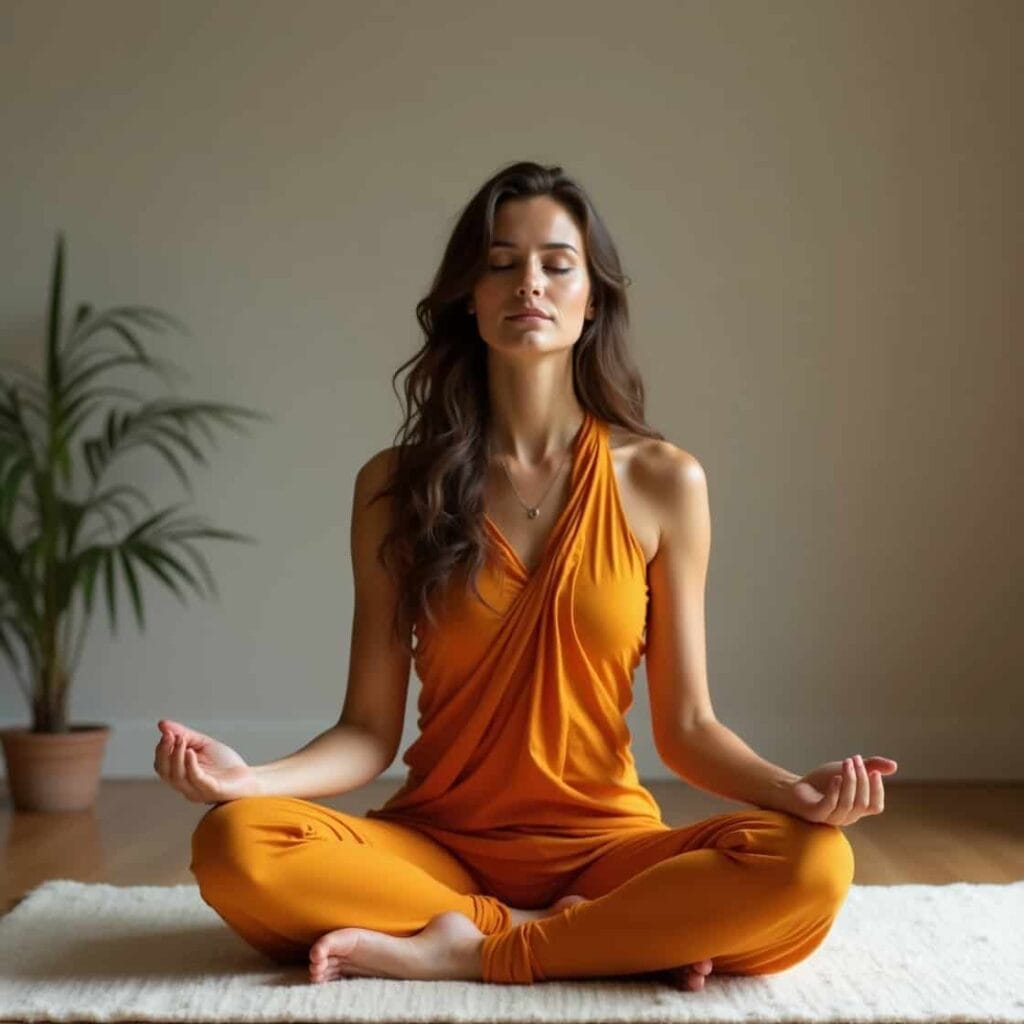
Ever heard about the mental clarity from Vipassana meditation technique? You might wonder—what do you actually do? Just sit still, or is there more to it? (Hint: It’s not about napping with your eyes open.)
Here’s the deal: Vipassana technique trains you to notice thoughts, feelings, and body sensations—without reacting. No magic, no fuss. Just you, your breath, and a whole lot of patience. (Spoiler: Your mind will wander. A lot.)
This guide breaks down the Vipassana technique simply. Perfect for beginners, but true to its roots. Whether you’re practicing at home (without turning into a stiff statue) or prepping for a retreat, you’ll learn how it really works.
Ready? Let’s begin
Explain the Vipassana Meditation Technique.
Let’s be honest – most meditation guides sound like they were written by a monk who’s never had to sit through a boring work meeting. Not this one.
First, what even is Vipassana? It’s about seeing reality clearly, without your brain’s usual drama. You know how you’ll feel a tiny itch and suddenly you’re planning your funeral? (“What if it’s skin cancer?!”) Well, this technique teaches you to notice sensations without the mental freakout.
Traditionally, you’d learn this during an intense 10-day silent retreat. But here’s the thing – you don’t need to go full hermit to benefit. In fact, you can start right now in your living room. Just find a quiet spot (good luck if you have kids/pets/neighbors who love karaoke).
Here’s how it works in practice
- Sit comfortably (no, you don’t need to twist like a pretzel)
- Focus on your natural breath (not the “perfect” Instagrammed breath)
- When your mind wanders (and it will), gently bring it back without judging yourself
The magic happens when you start noticing:
- That tense shoulder you’ve been ignoring for weeks
- How your mind jumps from “I’m hungry” to “I should call my mom” in 2.5 seconds
- All the random noises your house makes when you actually sit still
Best part? You don’t need special gear, apps, or a Himalayan cave. Just you, your breath, and maybe a timer so you don’t peek every 30 seconds. Start with 5 minutes – even that will feel like forever at first.
Pro tip: If you catch yourself thinking “Am I doing this right?” – congratulations! That’s the practice. There’s no “perfect” meditation, just showing up and trying again.
Step-by-Step Guide to Practicing Vipassana Meditation Technique
Step 1: Find a Relaxed, Cozy Space to Do Vipassana Meditation.
First things first – you need a place where you won’t be interrupted by roommates, pets, or your own sudden urge to reorganize the pantry. Ideally, pick a quiet corner (but let’s be real, “quiet” is relative—just aim for “less chaotic”).
Now, sit down. You’ve got options:
- Cross-legged on a cushion (if you’re flexible—or willing to pretend)
- On a chair with your back straight (like you’re pretending to care in a work meeting)

Step 2: Breathe Like You Mean It (Anapana Time!)
Alright, here’s where things get real – we’re focusing on your breath. Not the dramatic “oh no I forgot my keys” kind of breathing, but your normal, everyday inhales and exhales.

Here’s how it works:
- Tune into those subtle nose-tickles as air goes in and out (yes, really – it’s not as weird as it sounds)
- When your brain inevitably wanders to dinner plans or that embarrassing thing you did in 2014 (we’ve all been there), gently bring it back to breath-town
Pro tip: Start with 10-15 minutes. *That’s 1-2 songs worth of time* – except instead of singing along, you’re learning to actually notice your nostrils. Progress!
Step 3:To practice Vipassana meditation technique , scan your body from head to toe.
Okay, time to get scanning – and no, we’re not talking about grocery store barcodes. Here’s the deal: you’re going to slowly check in with each body part, from your scalp right down to your pinky toes (yes, even that weird toe you never think about).

What to notice:
- That random itch behind your knee (don’t scratch it!)
- The way your shoulders are hugging your ears like they’re cold
- Any spots that feel numb, tingly, or suspiciously like you slept wrong
Important rule: You’re just observing, not playing doctor. Feeling a twinge? Notice it and move on – this isn’t WebMD time.
Time commitment: Start with 20 minutes (about half a sitcom episode), working up to 45 as you get better at ignoring the urge to fidget. Bonus points if you make it through without planning your grocery list
Step 4: Use the Vipassana meditation technique to maintain your composure.
Now for the real test – staying chill when your body throws surprises at you. Here’s the secret sauce of Vipassana: whether you’re feeling blissful waves or an angry toe cramp, your job is to notice without freaking out.

What this looks like in practice:
- That warm, floaty feeling? Enjoy it, but don’t cling.
- That sudden back pain? Notice it, but don’t start writing your will.
Why this matters: You’re training your brain to stop its two favorite habits:
- Grabbing at good stuff like it’s the last cookie
- Pushing away bad stuff like it’s expired milk
Pro tip: When your mind shouts “Make it stop!” or “I want more!”, just breathe and remember: This too shall pass… along with that weird tingling in your elbow.
Step 5: Use the vipassana meditation practice to conclude with Metta (Loving-Kindness).
Alright, don’t rush off just yet – we’ve got one final (and surprisingly tough) step. Now’s the time to send out some good vibes, what meditation nerds call Metta Bhavana (but you can just think of it as mental sunshine).

Here’s how it works:
- Start by wishing yourself well (because hey, you showed up – that counts)
- Then mentally high-five:
- Loved ones (easy mode)
- Neutral people (your barista, the mail carrier)
- And yes, even difficult people (this is where it gets real)
Pro tip: If you’re struggling to send love to someone, try this: “May you find better hobbies than annoying me.” Baby steps
How to Effectively Practice Vipassana
“Start ridiculously small” means beginning with laughably easy sessions—like just 5 minutes. Why? Because:
- You’ll actually do it (no “I don’t have time” excuse)
- Zero pressure to be a zen master on day one
- Hidden perk: Tiny wins build confidence (unlike those overly ambitious plans we abandon by January 3rd)
Think of it like learning guitar—you don’t start with “Stairway to Heaven,” you start with a single basic chord. Same idea.
Pro tip: Set a timer for 5 minutes. If you go longer? High five! If not? Still counts—the goal is just to show up.
❓ Frequently Asked Questions (FAQs)
1. So what exactly is Vipassana?
It’s like becoming a neutral scientist of your own body. You sit quietly, notice tingles/itches/weird pains (without freaking out), and train your mind to stay chill through it all. Basically, mindfulness bootcamp.
2. How’s it different from other meditations?
Good question! Most meditations focus on breath or mantras. But Vipassana? It’s all about raw observation—like watching your thoughts and body sensations as if they’re Netflix subtitles (just don’t actually open Netflix).
3. Do I need a expert in a cave to teach me?
Not necessarily. While 10-day courses are gold standard, you can start at home. Pro tip: Use reliable guides (not that sketchy YouTube video with the weird background music).
4. How long until I become a zen master?
Hold up, tiger. Start with 15-20 minutes (about the time it takes to microwave dinner). Eventually, work up to an hour—but no rush. This isn’t a race, unless you’re racing your own distractions.
5. What’s the big prize at the end?
Freedom from your brain’s drama! Seriously though, you’ll:
Final Thoughts: More Than Just “Chill Time”
Let’s be real—Vipassana isn’t your average “feel-good quick fix.” Here’s the truth: it rewires how you handle life’s chaos. That coworker who drives you nuts? Traffic jams? You’ll start seeing them like weather patterns—there, but not yours to freak out about.
The magic happens when you:
- Notice thoughts/sensations without buying into them (like watching bad TV—no need to yell at the characters)
- Respond to life instead of reacting (game-changer for relationships, trust me)
- Discover that real peace comes from awareness, not perfect circumstances
So remember:
- Start small (5 minutes counts!)
- Be kind to your wandering mind—it’s learning
- Stick with it—this isn’t instant coffee, it’s slow-brewed wisdom
Final pro tip: Your progress might feel invisible… until one day you realize you didn’t snap at your alarm clock. That’s the Vipassana effect.
🔗 Love mindful living? Follow us on Pinterest for daily meditation tips, peaceful visuals, and more 🧘
Recommended Reads:





There’s a poetic stillness in your prose that invites deeper contemplation and leaves a lasting impression.